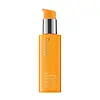What's inside
What's inside
 Key Ingredients
Key Ingredients

 Benefits
Benefits

 Concerns
Concerns

No concerns
 Ingredients Side-by-side
Ingredients Side-by-side

Water
Skin ConditioningGlycerin
HumectantDecyl Glucoside
CleansingAmmonium Acryloyldimethyltaurate/Vp Copolymer
Cocamidopropyl Betaine
CleansingCitrus Sinensis Fruit Extract
AntioxidantPhenoxyethanol
PreservativeGlycolic Acid
BufferingDisodium EDTA
3-O-Ethyl Ascorbic Acid
Skin ConditioningEthylhexylglycerin
Skin ConditioningLactic Acid
BufferingSodium Lactate
BufferingPropylene Glycol
HumectantSodium Sulfite
PreservativePunica Granatum Extract
AstringentAlcohol Denat.
AntimicrobialAnanas Sativus Fruit Extract
Skin ConditioningPassiflora Quadrangularis Fruit Extract
Skin ProtectingVitis Vinifera Fruit Extract
Skin ConditioningParfum
MaskingCitral
PerfumingLimonene
PerfumingWater, Glycerin, Decyl Glucoside, Ammonium Acryloyldimethyltaurate/Vp Copolymer, Cocamidopropyl Betaine, Citrus Sinensis Fruit Extract, Phenoxyethanol, Glycolic Acid, Disodium EDTA, 3-O-Ethyl Ascorbic Acid, Ethylhexylglycerin, Lactic Acid, Sodium Lactate, Propylene Glycol, Sodium Sulfite, Punica Granatum Extract, Alcohol Denat., Ananas Sativus Fruit Extract, Passiflora Quadrangularis Fruit Extract, Vitis Vinifera Fruit Extract, Parfum, Citral, Limonene
 Reviews
Reviews

Ingredients Explained
These ingredients are found in both products.
Ingredients higher up in an ingredient list are typically present in a larger amount.
Glycerin is already naturally found in your skin. It helps moisturize and protect your skin.
A study from 2016 found glycerin to be more effective as a humectant than AHAs and hyaluronic acid.
As a humectant, it helps the skin stay hydrated by pulling moisture to your skin. The low molecular weight of glycerin allows it to pull moisture into the deeper layers of your skin.
Hydrated skin improves your skin barrier; Your skin barrier helps protect against irritants and bacteria.
Glycerin has also been found to have antimicrobial and antiviral properties. Due to these properties, glycerin is often used in wound and burn treatments.
In cosmetics, glycerin is usually derived from plants such as soybean or palm. However, it can also be sourced from animals, such as tallow or animal fat.
This ingredient is organic, colorless, odorless, and non-toxic.
Glycerin is the name for this ingredient in American English. British English uses Glycerol/Glycerine.
Learn more about GlycerinWater. It's the most common cosmetic ingredient of all. You'll usually see it at the top of ingredient lists, meaning that it makes up the largest part of the product.
So why is it so popular? Water most often acts as a solvent - this means that it helps dissolve other ingredients into the formulation.
You'll also recognize water as that liquid we all need to stay alive. If you see this, drink a glass of water. Stay hydrated!
Learn more about Water